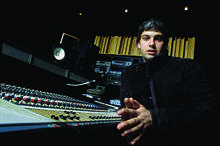Music2titan
Music2titan is the name given to four musical themes composed by French musicians Julien Civange and Louis Haeri that were placed on board ESA's Huygens probe in October 1997. "Hot Time", "Bald James Deans", "Lalala" and "No Love" reached Titan on January 2005 after a 7 years and 4 billion km journey.
| "Music2titan" | |
|---|---|
 | |
| Composition by Julien Civange and Louis Haeri | |
| Released | October 1997 |
| Composer(s) | Julien Civange and Louis Haeri |
Vocation
Their vocation is to strengthen ESA and NASA's Cassini-Huygens mission to Saturn and Titan with the aim to leave trace of our humanity to the unknown and build awareness about this adventure.
The music
Designed as a film soundtrack, each Music correspond to a special step of the mission.
Lalala: built around 3 base rock chords, this song corresponds to before the beginning of the mission, the making of the space probe in an atmosphere that is both naïve and serious at the same time. The men and women of the Space Agency in lab coats and overalls, like "Playmobils", busy building Huygens in giant hangars.
Bald James Dean: this song is dramatically tense, evoking the separation of the space probes Cassini and Huygens, which will take place at Christmas before the descent of Huygens towards Titan where it will arrive on 14 January 2005.
Hot Time: this piece is more space-like but also urban which corresponds to the exploration of Titan.
No Love: this corresponds to the end of the mission, a calm after so many years of work. It is also slightly melancholy which raises the questions linked to the conquest and the exodus of space: "What will we export there? Our dustbins, our fast-food, our knowledge, Wall Street, Che Guevara, the Mona Lisa, Bart Simpson…?" (JC)
Quote
"Music2Titan reflects a wish to highlight mankind's existence in the universe through music and to familiarize people with the spatial exodus and possible existence of extra-terrestrial life", said Julien Civange, producer, musician and initiator of Music2Titan. "It also serves as a way to offer people hope for the future and to make music travel beyond normal boundaries".
Distribution
In 2004, Julien Civange organised the distribution and promotion of these music throughout the world by putting in place a system of online only distribution-more adapted to follow the planning of a space mission than a physical distribution !
Music2titan manifesto in 10 points
- Embellish the Earth and space with revolutionary artistic projects.
- Participate in Man's space exodus.
- Familiarize Man with space travel and extraterrestrial life.
- Send a human sign to extraterrestrial populations.
- Be enlighteners.
- Open a popular debate on mankind's fate in space.
- Communicate about the universe and science away from the scientific framework.
- Disseminate dreams.
- Use the market players to participate in educative, social and entertaining actions.
- Participate to the dematerialization of media.
Support
The ongoing progress and news was released by the media around the world, the site created for the occasion received millions of visits from more than 110 countries and thousands of e-mails from around the globe.
The depositions of support flowed in from around the world, from the simple man in the street to the stars of the scientific world, to the stars of the entertainment world, like Mick Jagger who declared in a press statement : Mick Jagger said (see: [1]) : "Music has always been at the centre of cultures all over the world and I believe it will continue to play an important part in thousands of years time. Music has a role in the same way as technology and science in reflecting the age we live in and generally exploring new areas beyond the accepted boundaries and beyond earth. The music on board the spacecraft offers a very human touch to the project and at the same time provides an important educational aspect to the mission about outer space and contributes positively to the debate about whether there is any other planet or moon which can potentially sustain life."